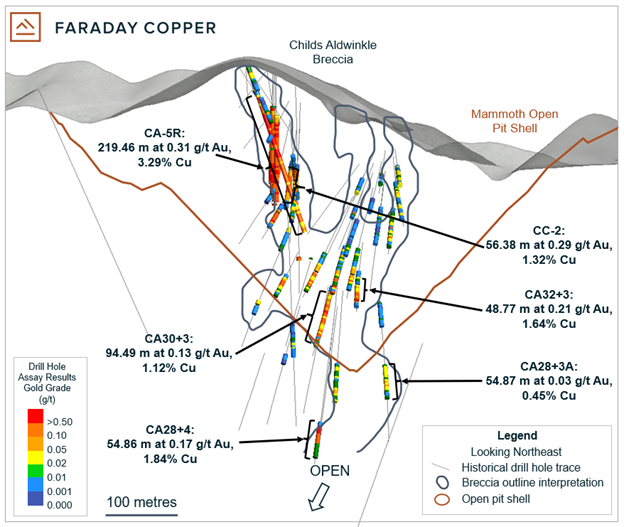
Faraday Copper (TSX:FDY) recently announced the results of gold assays from archived material from the Childs Aldwinkle breccia at their Copper Creek project in Arizona, USA. The samples, which had not been previously tested for gold, were analyzed to improve data coverage. The outcomes have reinforced the company’s position that the project holds extractable gold, adding another layer of value to the site.
Paul Harbidge, President and CEO, commented in a press release: “We are pleased to provide the first results of the gold program after completing analysis of the Childs Aldwinkle breccia. The results show near-surface gold mineralization in the current resource pit shell and demonstrate the potential to add a gold by-product, further enhancing the value of the project. The team has been able to advance our thesis of payable gold in the resource by utilizing the historical drill core and pulps that previous operators did not analyze for gold. With Childs Aldwinkle assay results now received, the Company is currently preparing samples from other high-priority breccias and we look forward to presenting results as they are available.”
In past results, the focus of sample analysis was largely on copper, with gold getting considerably less attention. Faraday Copper aims to increase the amount of gold data available for potential incorporation into future resource updates. Besides gold, the samples are also being reassessed for copper, silver, and molybdenum to cross-check historical findings. Childs Aldwinkle is the first breccia selected for this multi-elemental analysis.
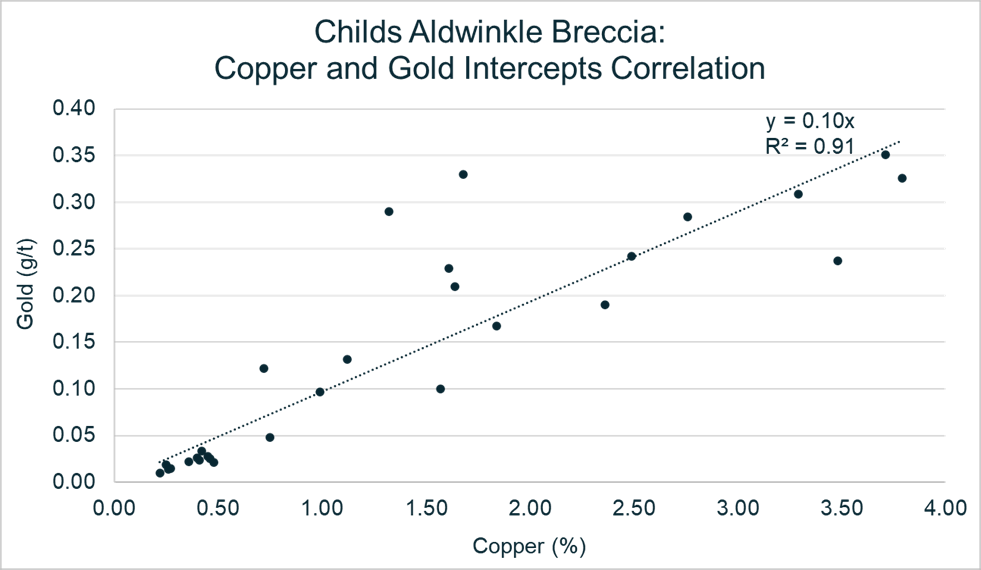
The results from Childs Aldwinkle indicated a robust correlation between gold and copper, observed as a 1:10 gold (g/t):copper (%) ratio. According to a technical report effective as of May 3, 2023, the breccia is estimated to contain about 3.3 million tonnes of mineralized material. This correlation suggests that the gold is mineralogically bound with copper and is expected to be included in copper concentrate. However, it’s important to note that this ratio and gold presence have not yet undergone a complete metallurgical or economic assessment, which means it is not yet classified as part of an official mineral resource.
Faraday Copper has initiated a metallurgical program to gather more information on the recoverability of gold. This will involve variability tests across multiple breccia domains to further understand how gold behaves in different settings.
Looking ahead, Faraday Copper plans to continue re-analyzing older samples, with an eye towards potentially including more gold data in future resource estimations. Additional areas under consideration for this gold program include the Copper Prince and Pole breccias, as well as the Keel underground zone. A new drilling program is set to kick off in October 2023, aiming to expand the Mineral Resource Estimate, better outline high-grade mineralized zones, and perform reconnaissance drilling on new targets.
The company is working towards releasing an updated technical report in the first half of 2025. This will include findings from their upcoming Phase II and III drilling programs, the ongoing gold program, and metallurgical studies.
Highlights from the results are as follows:
- Significantly increased analytical coverage for gold at Childs Aldwinkle with 743 new gold assay results in addition to 120 historical gold results.
- Examples of intercepts with new gold assays and re-assayed copper include:
- 219.46 m (“metres”) at 3.29% copper and 0.31 g/t gold from 24.38 m in drill hole CA-5R;
- 94.49 m at 1.12% copper and 0.13 g/t gold from 341.38 m in drill hole CA30+3; and
- 56.38 m at 1.32% copper and 0.29 g/t gold from 150.88 m in drill hole CC-2.
- A weighted average of 0.16 g/t gold and 1.52% copper is calculated for mineralized intercepts for which gold analytical data is available1.
- Gold and copper are well-correlated on an intercept basis with an overall ratio of approximately 1:10 gold (g/t):copper (%) at Childs Aldwinkle.
- Historical metallurgical test work suggests high gold recoveries in the copper concentrate. The Company has initiated a metallurgical program to confirm gold recoveries.
- As part of the gold program, copper was re-assayed. These results confirm historical data, providing additional confidence in the database.
- Phase III drill program is expected to commence in October 2023.
Table 1: Intercept values at the Childs Aldwinkle breccia
| Drill Hole ID | From | To | Length | True width | Cu | Au | Ag | Mo |
| (m) | (m) | (m) | (m) | (%) | (g/t) | (g/t) | (%) | |
| CA-4R | 12.19 | 30.84 | 18.65 | N/A | 0.48 | 0.02 | 1.47 | 0.0042 |
| CA-4R | 64.01 | 82.30 | 18.29 | N/A | 0.36 | 0.02 | 0.82 | 0.0016 |
| CA-5R | 24.38 | 243.84 | 219.46 | N/A | 3.29 | 0.31 | 13.88 | 0.0770 |
| CA28+3A | 441.96 | 496.83 | 54.87 | 32 | 0.45 | 0.03 | 1.30 | 0.0004 |
| CA28+4 | 512.07 | 566.93 | 54.86 | 30 | 1.84 | 0.17 | 4.69 | 0.0320 |
| CA30+3 | 341.38 | 435.87 | 94.49 | 60 | 1.12 | 0.13 | 4.55 | 0.0230 |
| CA30+4 | 438.91 | 496.83 | 57.92 | 36 | 0.40 | 0.03 | 1.08 | 0.0006 |
| CA32+3 | 341.38 | 390.15 | 48.77 | 34 | 1.64 | 0.21 | 5.50 | 0.0320 |
| CA32+5 | 330.40 | 360.88 | 30.48 | 21 | 0.99 | 0.10 | 3.69 | 0.0800 |
| CA32+6 | 256.03 | 289.56 | 33.53 | 22 | 0.27 | 0.02 | 0.67 | 0.0031 |
| CA34+3 | 234.70 | 271.27 | 36.57 | 22 | 0.75 | 0.05 | 2.26 | 0.1106 |
| CA34+4 | 234.70 | 280.42 | 45.72 | 28 | 1.57 | 0.10 | 5.62 | 0.0285 |
| CA34+4A | 243.84 | 274.32 | 30.48 | 19 | 0.72 | 0.12 | 3.17 | 0.1007 |
| CA35.5+1 | 176.78 | 234.70 | 57.92 | 44 | 0.42 | 0.03 | 1.85 | 0.0130 |
| CA35.5+3 | 225.55 | 234.70 | 9.15 | 7 | 0.25 | 0.02 | 0.92 | 0.0016 |
| CA36+7 | 249.94 | 277.37 | 27.43 | 22 | 2.49 | 0.24 | 9.74 | 0.0867 |
| CA37.5+1 | 146.30 | 179.83 | 33.53 | 28 | 0.41 | 0.02 | 1.15 | 0.0113 |
| CA37.5+1A | 124.97 | 173.74 | 48.77 | 44 | 0.46 | 0.03 | 2.25 | 0.0746 |
| CA37.5+2 | 134.11 | 158.50 | 24.39 | 22 | 0.26 | 0.01 | 0.72 | 0.0601 |
| CA38+7 | 149.35 | 184.10 | 34.75 | 22 | 2.36 | 0.19 | 9.31 | 0.0179 |
| CA40+7 | 116.43 | 135.64 | 19.21 | 17 | 3.48 | 0.24 | 10.59 | 0.0649 |
| CC-2 | 150.88 | 207.26 | 56.38 | 36 | 1.32 | 0.29 | 5.53 | 0.0205 |
| MET-2CA | 45.72 | 169.16 | 123.44 | N/A | 3.79 | 0.33 | 11.57 | 0.0486 |
| MET-3CA | 45.72 | 152.40 | 106.68 | N/A | 3.71 | 0.35 | 11.27 | 0.0169 |
| FCD-23-023 | 184.72 | 230.61 | 45.89 | 35 | 1.68 | 0.33 | 5.55 | 0.0280 |
| FCD-23-027 | 390.72 | 408.98 | 18.26 | 9 | 0.22 | 0.01 | 1.58 | 0.0080 |
| CA-9R | 164.59 | 182.88 | 18.29 | N/A | 2.76 | 0.28 | 8.20 | 0.0206 |
| CATECH | 237.74 | 243.23 | 5.49 | N/A | 1.61 | 0.23 | 9.43 | 0.0014 |
| CA28+8 | No significant intercepts and incomplete gold data | |||||||
| CA30+6 | No significant intercepts | |||||||
| CA35.5+2 | No significant intercepts | |||||||
| CA36.5+2 | No significant intercepts | |||||||
| CA36.5+3 | No significant intercepts | |||||||
| CA36+8 | No significant intercepts | |||||||
Notes: Copper, silver and molybdenum columns indicate re-assayed metal values. Drill holes MET-2CA and MET-3CA were not re-assayed as part of this program. Drill holes CA40+7 and CC-2 are composite samples. For drill holes CA-9R and CATECH, gold data does not cover the entire mineralized intercept and lengths listed are for the portion for which gold data is available. True widths are approximate.
The above references an opinion and is for information purposes only. It is not intended to be investment advice. Seek a licensed professional for investment advice. The author is not an insider or shareholder of any of the companies mentioned above.
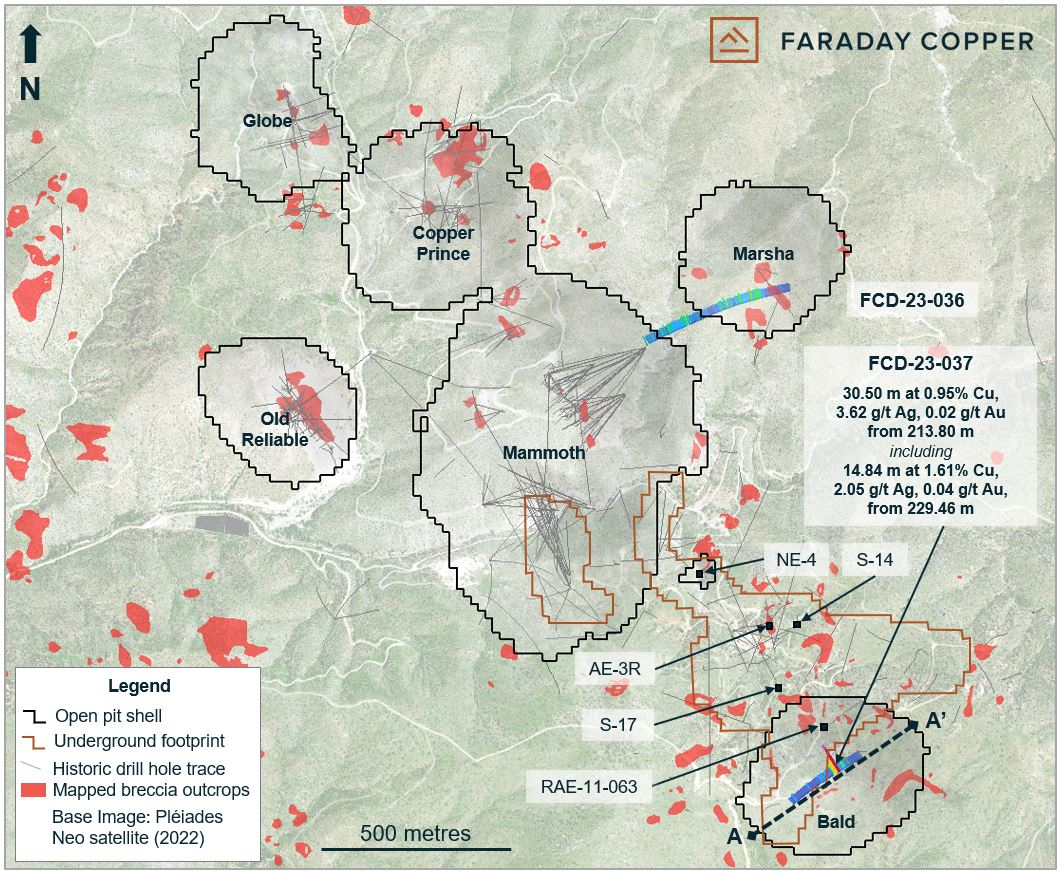
Faraday Copper (TSX:FDY) has disclosed the outcomes of the concluding two drill holes from the Phase II initiative at the Copper Creek Project, positioned in Arizona, USA. The purpose of these two holes was to evaluate the vertical extension of the breccia mineralization, above the American Eagle underground section, and target areas yet unexplored.
Drill hole FCD-23-037 started southwest of the Bald breccia and proceeded towards the northeast (Figures 1 and 2). This hole aimed to uncover the mineralization initially identified in a previous reverse circulation drill hole. FCD-23-037 was drilled as diamond core, showing that the mineralization is located in a crackle breccia made up of intensely sericite altered granodiorite fragments, glued together by chalcopyrite and pyrite (Figure 3). This breccia was intersected about 500 m above the American Eagle underground footprint. Historical extensive vertical drilling had not explored the vertical extension of this breccia, which is still open-ended. Further drilling in this area is slated as part of the Phase III program.
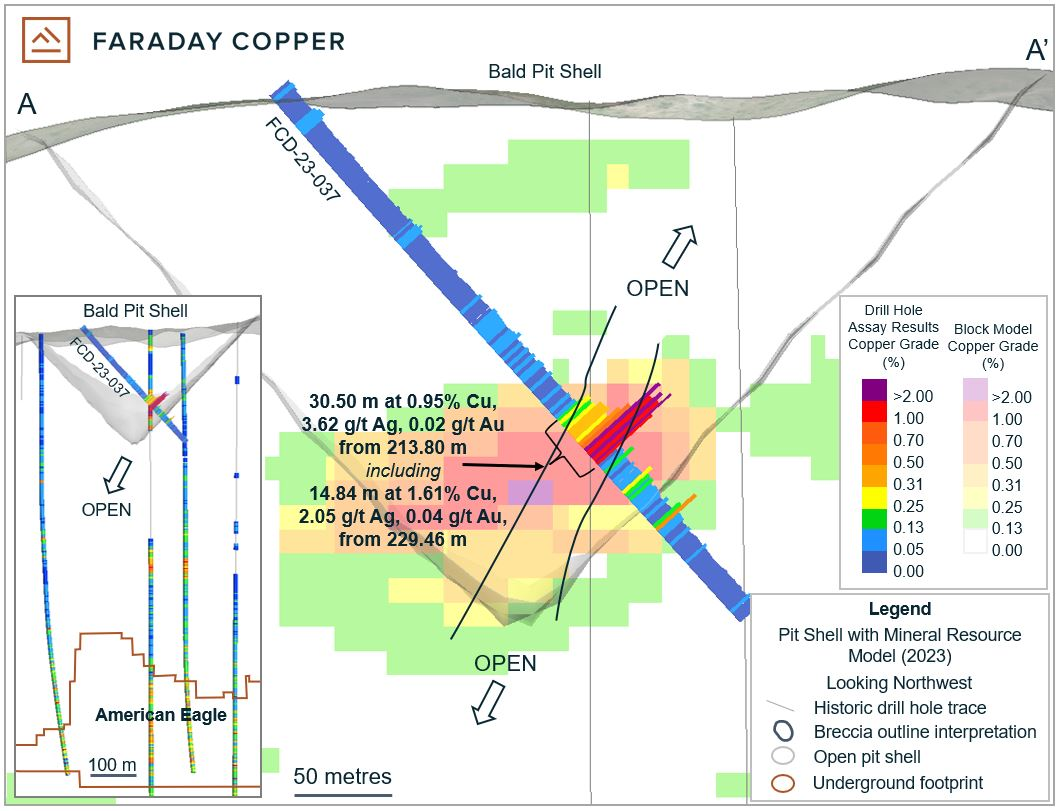
Drill hole FCD-23-036 commenced southwest of the Marsha pit shell and continued towards the northeast (Figure 1). The hole spans a drilling gap and verifies low-grade mineralization 160 m beneath the base of the Marsha pit shell utilized to limit the MRE. This drill hole points out that the Marsha area still offers prospects for resource expansion.
Historical drilling around the American Eagle region primarily targeted the gently dipping veins, which are crucial hosts of mineralization in the underground resource. The previous drilling was not ideally positioned for outlining the steeply dipping veins and breccia zones near the surface. Angled drilling in this zone is scheduled as part of the Phase III program to target open pit resource expansion.
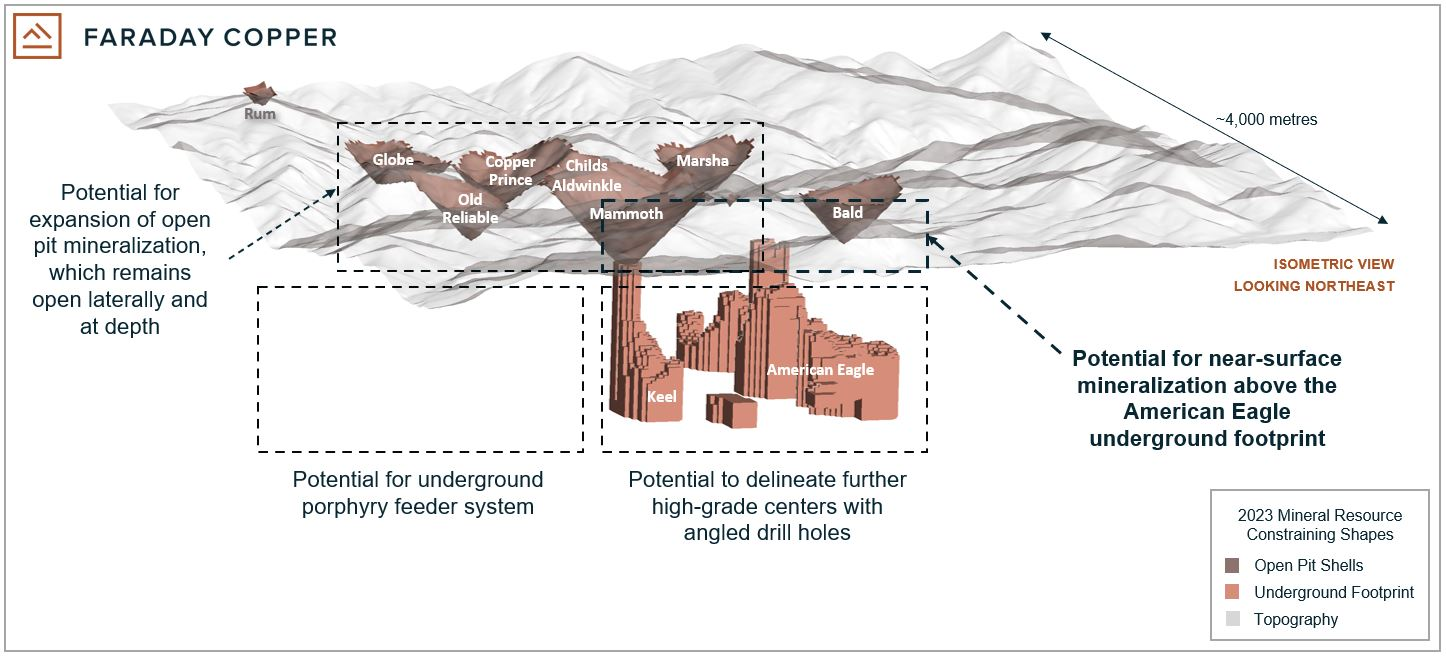
Historical findings, along with drill hole FCD-23-037, between the Mammoth and Bald pit shells, covering about one kilometre, emphasize the potential for mineralization to be outlined above the American Eagle porphyry between the surface and a depth of 500 m. Some instances of historical drill results suggesting near-surface potential include (Figure 1):
- 18.29 m at 0.94% Cu from 85.34 m (AE-3R)
- 18.23 m at 0.84% Cu from 39.62 m (S-14)
- 27.32 m at 0.51% Cu from 186.54 m (RAE-11-063)
- 21.33 m at 0.34% Cu from 6.10 m (NE-4)
- 70.10 m at 0.38% Cu from 176.78 m (S-17)
The Phase II drilling, comprising a total of twenty-eight drill holes, concluded in June 2023. This press release includes the results of the final two drill holes.
To categorize and prioritize targets for the 20,000-meter Phase III drill program, the company is combining and interpreting multiple datasets, including geological mapping, drill core, geochemistry, hyperspectral data, airborne magnetic, and electromagnetic geophysical data. The Phase III drill program is set to begin in the final quarter of 2023 with the following three goals:
- Expanding the MRE
- Enhancing delineation of high-grade mineralized zones
- Reconnaissance drilling on fresh targets
A program to assay historical drill core samples has been launched to evaluate the potential for inclusion of gold in future resource updates. Historically, approximately 12 percent of all core samples analyzed for copper were also analyzed for gold. As part of the program, the first breccia to be analyzed is Childs Aldwinkle, with 359 samples submitted to the laboratory. Results will be publicized as they are received, analyzed and confirmed by the Company. Following the completion of the Childs Aldwinkle assaying, the Copper Prince, Pole, and Copper Giant breccias, as well as the Keel underground zone, will be prioritized for gold analysis.
The Phase II metallurgical program has started, focusing on grind size optimization to evaluate the feasibility of coarser particle flotation, gold deportment to concentrate, and further test work on near-surface mineralization.
Highlights from the results are as follows:
- Intersected 30.50 metres (“m”) at 0.95% copper, 3.62 g/t silver and 0.02 g/t gold from 213.80 m, including 14.84 m at 1.61% copper, 2.05 g/t silver and 0.04 g/t gold from 229.46 m in drill hole FCD-23-037 at the Bald breccia. (For true width information see Table 1)
- This result confirms near-surface, high-grade breccia mineralization within the Bald resource pit shell and highlights the potential for resource expansion above the American Eagle porphyry.
- Results from Phase II drilling, along with new geophysical data, spectral data and geological mapping, will contribute to ranking and prioritizing targets for a 20,000-metre Phase III drill program planned to commence in the fourth quarter of 2023.
- A metallurgical program has commenced and is focused on grind size optimization, gold deportment and further test work on near surface mineralization.
- Analysis of historical drill core for gold in selected breccias is in progress.
Table 1: Selected Drill Results from Copper Creek
| Drill Hole ID | From | To | Length | True Width | Cu | Mo | Au | Ag |
| (m) | (m) | (m) | (m) | (%) | (%) | (g/t) | (g/t) | |
| FCD-23-037 | 213.80 | 244.30 | 30.50 | 24 | 0.95 | 0.009 | 0.02 | 3.62 |
| including | 229.46 | 244.30 | 14.84 | 12 | 1.61 | 0.008 | 0.04 | 2.05 |
| FCD-23-036 | 447.54 | 487.12 | 39.58 | 39 | 0.16 | 0.006 | N/A | 0.41 |
Notes: All intercepts are reported as downhole drill widths. Mineralization includes bulk porphyry-style zones and breccia mineralization. Porphyry-style zones true widths are interpreted to be close to drilled widths. Breccia true widths are approximate due to the irregular shape of mineralized domains.
Table 2: Collar Locations from the Drill Holes Reported Herein
| Drill Hole ID | Easting | Northing | Elevation | Azimuth | Dip | Target | Depth | Depth |
| (m) | (°) | (°) | (ft) | (m) | ||||
| FCD-23-037 | 549088 | 3622920 | 1374 | 050 | -50 | Bald Breccia | 1148.0 | 349.91 |
| FCD-23-036 | 548678 | 3624198 | 1245 | 062 | -45 | Marsha Deep | 1968.0 | 599.85 |
Note: Coordinates are given as World Geodetic System 84, Universal Transverse Mercator Zone 12 north (WGS84, UTM12N).
The above references an opinion and is for information purposes only. It is not intended to be investment advice. Seek a licensed professional for investment advice. The author is not an insider or shareholder of any of the companies mentioned above.

Faraday Copper (TSX:FDY), a Canadian copper exploration company, announced today the latest results from a series of drill holes at its flagship Copper Creek Project, situated in Arizona, U.S. The findings suggest promising mineralization, reinforcing the project’s potential for robust copper production and hinting at significant gold presence.
The company’s report highlighted a 45.89-meter intersection at the Childs Aldwinkle breccia complex, boasting 1.68% copper, 0.33 g/t gold, 5.55 g/t silver, and 0.028% molybdenum, starting from 184.72 meters in drill hole FCD-22-023. This notable find suggests considerable gold prospects that were not factored into the Mineral Resource Estimate (MRE) earlier this month.
Paul Harbidge, President and CEO, commented in a press release: “The continued success of our Phase II drill program confirms our view that there is significant upside to the open pit and underground resource utilized as the basis for the PEA. In particular, drill hole FCD-23-023 returned high copper grades and enrichment in gold. This highlights the potential to add gold credits to the current resource through both future drilling and our ongoing assaying of historical core and pulps that were not analyzed in the past. We look forward to providing updates as we progress.”
Drill hole FCD-23-025 revealed further interesting data, intersecting 136.48 meters with 0.54% copper and 0.83 g/t silver from 278.61 meters. The findings also include a significant 66.26 meters with 0.87% copper and 1.22 g/t silver, and a noteworthy 309.43 meters at 0.31% copper and 0.83 g/t silver. This significant intersection testifies to the mineralization between the Keel and American Eagle underground zones, indicating that there’s still much to discover.
Alongside these findings, Faraday Copper has embarked on a gold assaying program. This initiative aims to analyze historical drill core to gauge its potential for inclusion in future resource updates, as well as for metallurgical testing purposes.
Drill hole FCD-22-023, set southwest of Childs Aldwinkle, exhibited potential for substantial gold mineralization within the high-grade copper mineralization of the open pit resource. Further, drill hole FCD-23-025, initiated west of Mammoth, confirmed the potential for continuous mineralization between two underground footprints, suggesting the need for additional exploration.
Two more holes, FCD-23-021 and FCD-23-022, targeted the yet unexplored Hilltop breccia, east of Copper Prince. Both intersected near-surface mineralization above the cut-off grade for the open pit mineral resource, indicating potential for further exploration.
Finally, reconnaissance drill holes FCD-22-019 and FCD-22-020 probed the Gin breccia, north of the mineral resource area. Both intersected over 100 meters of pyrite cemented breccia, revealing anomalous silver and suggesting potential copper mineralization below the current drilling depth.
As the Phase II drilling is underway, Faraday Copper is preparing to launch a series of geological mapping, rock sampling, and geophysical data collection to guide future drill campaigns, scheduled for the fourth quarter of 2023.
Faraday Copper Corp., with a strong focus on its principal copper project in the U.S., is committed to exploring the full potential of Copper Creek, one of North America’s largest undeveloped copper projects. The company is well-capitalized to meet its key milestones and benefits from a seasoned management team and board of directors with substantial mining company experience and expertise.

Highlights from the results are as follows:
- Intersected 45.89 metres (“m”) at 1.68% copper, 0.33 g/t gold, 5.55 g/t silver and 0.028% molybdenum from 184.72 m at the Childs Aldwinkle breccia complexin drill hole FCD-22-023 (Figures 1 and 2). This hole highlights the potential gold upside on the property, which was not included in the Mineral Resource Estimate (“MRE”) (see news release dated May 3, 2023).
- Intersected 136.48 m at 0.54% copper and 0.83 g/t silver from 278.61 m, including 66.26 m at 0.87% copper and 1.22 g/t silver from 278.61 m, and 309.43 m at 0.31% copper and 0.83 g/t silver from 693.16 m in drillhole FCD-23-025 (Figures 1 and 3). The upper intersection from 278.61 m corresponds to the Mammoth breccia whereas the lower portion of the hole was aimed at testing the gap between the Keel and American Eagle underground footprints. The hole confirms mineralization in this gap, where drill density remains limited.
- Commenced a gold assaying program of historical drill core to determine the potential for inclusion in future resource updates. Samples will also be taken for metallurgical test work.
Table 1: Selected Drill Results from Copper Creek
| Drill Hole ID | From | To | Length | True width | Cu | Mo | Au | Ag |
| (m) | (m) | (m) | (m) | (%) | (%) | (g/t) | (g/t) | |
| FCD-23-023 | 184.72 | 230.61 | 45.89 | 35 | 1.68 | 0.028 | 0.33 | 5.55 |
| FCD-23-025 | 278.61 | 415.09 | 136.48 | 88 | 0.54 | 0.001 | <0.01 | 0.83 |
| including | 278.61 | 344.87 | 66.26 | 43 | 0.87 | 0.001 | <0.01 | 1.22 |
| and | 462.47 | 506.08 | 43.61 | 43 | 0.20 | 0.001 | <0.01 | 0.55 |
| and | 693.16 | 1,002.59 | 309.43 | 309 | 0.31 | 0.003 | 0.02 | 0.83 |
| FCD-23-021 | 6.00 | 44.86 | 38.86 | 38 | 0.18 | <0.001 | N/A | 0.54 |
| FCD-23-022 | 8.89 | 69.24 | 60.35 | 60 | 0.16 | <0.001 | N/A | 0.18 |
| FCD-22-019 | No significant intercepts | |||||||
| FCD-22-020 | No significant intercepts | |||||||
Notes: All intercepts are reported as downhole drill widths. True widths are approximate due to the inherently irregular shape of mineralized domains. Gold values reported as <0.01 g/t indicate concentrations of less than 10 times the analytical limit of detection (0.001 g/t). Molybdemun values of less than 10 parts per million are listed as < 0.001%.
Table 2: Collar Locations from the Drill Holes Reported Herein
| Drill Hole ID | Easting | Northing | Elevation | Azimuth | Dip | Target | Depth | Depth |
| (m) | (°) | (°) | (ft) | (m) | ||||
| FCD-23-023 | 548345 | 3623971 | 1,306 | 045 | -47 | Childs Aldwinkle | 813.8 | 267.00 |
| FCD-23-025 | 548225 | 3623757 | 1,181 | 110 | -60 | American Eagle | 3,195.9 | 1,048.51 |
| FCD-23-021 | 548429 | 3624688 | 1,349 | 230 | -45 | Hilltop | 457.3 | 150.04 |
| FCD-23-022 | 548429 | 3624689 | 1,349 | 278 | -45 | Hilltop | 384.8 | 126.25 |
| FCD-22-019 | 547071 | 3625879 | 1,387 | 200 | -53 | Gin | 610.9 | 200.44 |
| FCD-22-020 | 547070 | 3625880 | 1,387 | 245 | -50 | Gin | 761.8 | 249.94 |
Note: Coordinates are given as World Geodetic System 84, Universal Transverse Mercator Zone 12 north (WGS84, UTM12N).
The above references an opinion and is for information purposes only. It is not intended to be investment advice. Seek a licensed professional for investment advice. The author is not an insider or shareholder of any of the companies mentioned above.
Faraday Copper (TSX:FDY) has reported new assay results from three drill holes at its Copper Creek Project in Arizona. The company is targeting the potential expansion of the open pit mineral resource with these holes and has seen significant results. Faraday’s Copper Creek Project is one of the largest undeveloped copper projects on the continent.

It contains both open pit and bulk underground mining potential, for which the company is well-funded to deliver on. Faraday is composed of an experienced management team and board of directors that bring a range of expertise to the project and the ongoing mineral resource expansion.
To-date, the company has completed 16 drill holes at the project with results for nine of the drill holes already released. Results are being released as they are received, analyzed and confirmed by Faraday.
Paul Harbidge, President and CEO of Faraday Copper, commented in a press release: “This is one of the most exciting results from our Phase II drill program as it continues to demonstrate the potential to expand the open pit mineral resource. Importantly, mineralization remains open. This result is extremely encouraging for the growth potential of the Copper Creek project.”

Highlights from the results are as follows:
- Intersected 100.12 metres (“m”) at 0.69% copper and 1.15 grams per tonne (“g/t”) silver from 34.88 m at the Copper Giant breccia in drill hole FCD-22-012. Approximately 85 m of this intersection are outside the pit shell used to constrain the Mineral Resource Estimate (“MRE”) and provide the potential for an increase to the current open pit resource (Table 1, Figures 1, 2). Mineralization remains open at depth and to the southwest; and
- Intersected 8.32 m at 1.62% copper and 2.54 g/t silver from 5.64 m, and 9.64 m at 0.31% copper and 1.15 g/t silver from 110.55 m in drill hole FCD-22-015. Both intersections are located outside of the MRE and demonstrate that the area north of Copper Giant remains prospective (Figure 1).
Drill hole FCD-22-012 was collared west of the Copper Giant breccia and drilled to the northeast. The mineralization occurs as chalcopyrite breccia cement within Copper Giant and highlights that the copper grade, continuity and volume of this mineralized domain may be significantly larger than the historic drilling suggested. Mineralization remains open at depth and to the southwest (Figures 1 and 2).
Drill hole FCD-22-015 was collared approximately 120 m to the northeast from drill hole FCD-22-014 and is located entirely outside of the MRE. The hole was drilled to the north into Glory Hole volcanics and granodiorite porphyry, where no previous drill data existed. The hole intersected high-grade, breccia-hosted mineralization from 5.64 m to 13.96 m. In addition, 9.64 m of copper mineralization was intersected within a wide sericite alteration halo between 75 m and the end of the hole at 156.60 m. Sericite alteration can be associated with high-grade mineralization in the district and this result merits additional drill testing.
Drill hole FCD-22-014 was collared at the same location as FCD-22-012 but drilled to the north. This hole was drilled into the Glory Hole volcanic host rock where no previous drill data existed. While no significant copper mineralization was identified, portions of this hole have intersected potassic and sericite alteration, suggesting that the hydrothermal system continues to the north from the current extent of drilling and, therefore, it remains a drill target.
Table 1: Selected Drill Results from Copper Creek
| Drill Hole ID | From | To | Length | True Width | Cu | Mo | Au | Ag |
| (m) | (m) | (m) | (m) | (%) | (ppm) | (g/t) | (g/t) | |
| FCD-22-012 | 34.88 | 135.00 | 100.12 | 71 | 0.69 | 25 | 0.04 | 1.15 |
| Including | 120.00 | 133.23 | 13.23 | 10 | 1.13 | 44 | 0.07 | 2.10 |
| FCD-22-015 | 5.64 | 13.96 | 8.32 | 8 | 1.62 | 74 | N/A | 2.54 |
| and | 110.55 | 120.18 | 9.64 | 9 | 0.31 | 18 | N/A | 1.15 |
| FCD-22-014 | No significant intercepts | |||||||
Notes: All intercepts are reported as downhole drill widths. Due to the insufficiently constrained geometry and irregular shape of mineralized domains, true widths are approximate.
Table 2: Collar Locations from the Drill Holes Reported Herein
| Drill Hole ID | Easting | Northing | Elevation | Azimuth | Dip | Target | Depth | Depth |
| (m) | (°) | (°) | (ft) | (m) | ||||
| FCD-22-012 | 548060 | 624729 | 1226 | 055 | -55 | Copper Giant | 518.7 | 170.08 |
| FCD-22-015 | 548143 | 3624819 | 1235 | 010 | -45 | North of Copper Giant | 477.6 | 156.60 |
| FCD-22-014 | 548060 | 3624729 | 1226 | 010 | -45 | North of Copper Giant | 467.6 | 153.31 |
| Total | 1463.9 | 479.99 |
Note: Coordinates are given as World Geodetic System 84, Universal Transverse Mercator Zone 12 north (WGS84, UTM12N).
Next Steps
Phase II drilling continues and is focussed on three objectives:
- Reconnaissance drilling on new targets;
- Expanding the MRE; and
- Better delineating high-grade mineralized zones.
The above references an opinion and is for information purposes only. It is not intended to be investment advice. Seek a licensed professional for investment advice. The author is not an insider or shareholder of any of the companies mentioned above.
If you would like to receive our free newsletter via email, simply enter your email address below & click subscribe.
CONNECT WITH US
Tweets
Tweet with hash tag #miningfeeds or @miningfeeds and your tweets will be displayed across this site.
MOST ACTIVE MINING STOCKS
Daily Gainers
 |
CMB.V | +900.00% |
         |
CCD.V | +100.00% |
         |
CASA.V | +30.00% |
         |
AAZ.V | +25.00% |
   |
RMI.AX | +25.00% |
   |
POS.AX | +25.00% |
         |
KGC.V | +20.00% |
         |
GDX.V | +20.00% |
         |
LPK.V | +16.67% |
         |
CCE.V | +16.67% |

 Follow us on Twitter
Follow us on Twitter Become our facebook fan
Become our facebook fan







